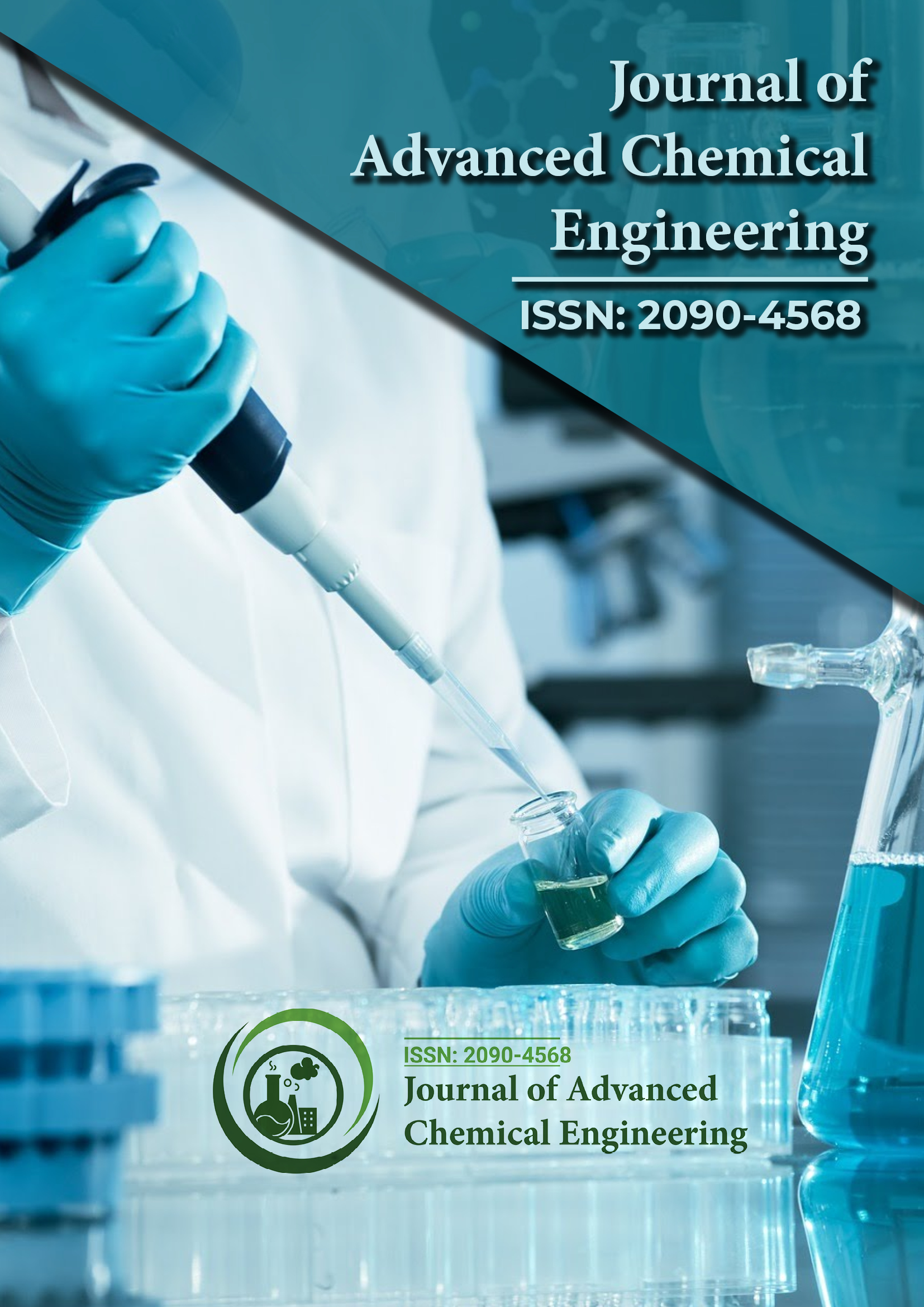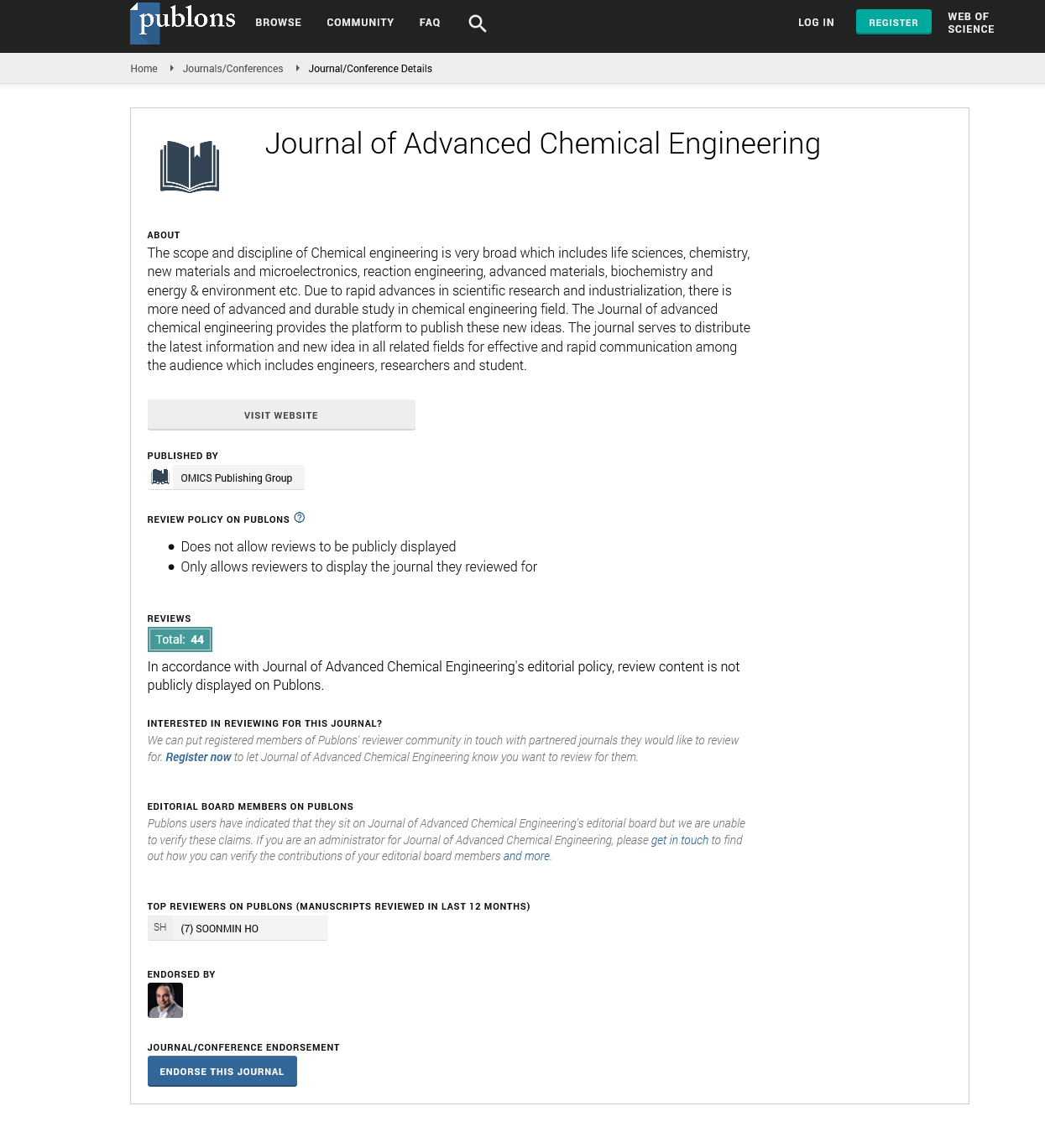Indexed In
- Open J Gate
- Genamics JournalSeek
- Smithers Rapra
- RefSeek
- Directory of Research Journal Indexing (DRJI)
- Hamdard University
- EBSCO A-Z
- OCLC- WorldCat
- Scholarsteer
- Publons
- Geneva Foundation for Medical Education and Research
- Google Scholar
Useful Links
Share This Page
Journal Flyer

Open Access Journals
- Agri and Aquaculture
- Biochemistry
- Bioinformatics & Systems Biology
- Business & Management
- Chemistry
- Clinical Sciences
- Engineering
- Food & Nutrition
- General Science
- Genetics & Molecular Biology
- Immunology & Microbiology
- Medical Sciences
- Neuroscience & Psychology
- Nursing & Health Care
- Pharmaceutical Sciences
Opinion Article - (2024) Volume 14, Issue 2
Electrocatalytic Enhancement through Organic Molecule-Induced Surface Chemical Modifications
Howard Castello*Received: 20-May-2024, Manuscript No. ACE-24-26623; Editor assigned: 22-May-2024, Pre QC No. ACE-24-26623 (PQ); Reviewed: 05-Jun-2024, QC No. ACE-24-26623; Revised: 12-Jun-2024, Manuscript No. ACE-24-26623 (R); Published: 19-Jun-2024, DOI: 10.35248/2090-4568.24.14.337
Description
Electrocatalysis is a field of immense significance in energy conversion and storage technologies, including fuel cells, electrolyzers, and batteries. The efficiency of electrocatalytic reactions often depends on the properties and interactions at the surface of the catalyst. Recent advances have focused on optimizing these surfaces by modifying their chemical microenvironments with organic molecules.
Understanding the surface chemical microenvironment
The surface chemical microenvironment of a catalyst refers to the local chemical and electronic conditions present at the catalyst's surface. These conditions are pivotal in determining the catalyst’s activity, selectivity, and stability.
Chemical interactions: Organic molecules can interact with the catalyst surface through various chemical bonds, including covalent, ionic, or hydrogen bonds. These interactions can alter the electronic properties of the catalyst, influencing its ability to facilitate electrochemical reactions.
Electronic effects: The introduction of organic molecules can induce electronic changes in the catalyst surface. These changes can modify the electronic structure of active sites, affecting their reactivity and selectivity.
Steric effects: Organic molecules can also create steric hindrances around the active sites of a catalyst. This can control the accessibility of reactants to these sites, impacting the overall catalytic performance.
Strategies for surface chemical microenvironment engineering
Several strategies are employed to engineer the surface chemical microenvironment of catalysts with organic molecules. These strategies aim to optimize the performance of catalysts in various electrocatalytic reactions.
Self-Assembled Monolayers (SAMs): SAMs are layers of organic molecules spontaneously organized on a surface. They are used to create a controlled chemical environment on the catalyst surface.
Monolayer formation: SAMs can be formed using molecules with reactive head groups that bind to the catalyst surface. The tail groups of these molecules can be tailored to impart desired properties, such as hydrophobicity or electron-donating capabilities.
Molecular adsorption and coating: Molecular adsorption involves the temporary attachment of organic molecules to the catalyst surface. Coatings, on the other hand, involve the application of a layer of organic molecules to modify the surface.
Covalent bonding: Covalent bonding involves forming strong chemical bonds between organic molecules and the catalyst surface. This method provides a stable modification that can significantly alter the catalyst's properties.
Applications
Oxygen Reduction Reaction (ORR): The ORR is a key reaction in fuel cells and metal-air batteries. Engineering the surface microenvironment of catalysts for ORR can enhance their performance.
Hydrogen Evolution Reaction (HER): HER is important for hydrogen production and fuel cell technologies. Modifying the catalyst surface with organic molecules can boost HER performance.
Carbon Dioxide Reduction Reaction (CO2RR): CO2RR is a promising method for carbon capture and conversion. Organic molecules can improve the performance of catalysts used for this reaction.
Challenges and future directions
Stability and durability: One challenge in surface modification with organic molecules is ensuring the stability and durability of the catalyst under operational conditions. Organic molecules may degrade or desorb from the surface over time, affecting the catalyst's performance.
Scalability and reproducibility: Scaling up the fabrication of catalysts with engineered surface microenvironments can be challenging. Ensuring reproducibility and consistency in large- scale production is essential for practical applications.
Understanding mechanisms: A deeper understanding of the mechanisms by which organic molecules affect the surface chemical microenvironment is needed. This knowledge will enable more precise engineering and optimization of catalysts for specific reactions.
Integration with nanomaterials: Combining organic molecules with nanomaterials offers a synergistic approach to enhance catalytic performance. Nanoparticles can serve as scaffolds for organic functionalization, providing both structural stability and enhanced surface area for catalytic activity.
Dynamic surface modifications: Exploring dynamic surface modifications where organic molecules can reversibly bind to the catalyst surface under certain conditions opens avenues for responsive catalytic behavior. This approach could lead to catalysts that adapt their activity based on environmental changes or specific catalytic requirements.
Multifunctional surface engineering: Beyond enhancing catalytic activity, organic molecules can impart multifunctionality to catalyst surfaces, such as improved resistance to corrosion or enhanced tolerance to poisoning species. This multifunctional approach is crucial for developing robust catalysts for practical applications.
Citation: Castello H (2024) Electrocatalytic Enhancement through Organic Molecule-Induced Surface Chemical Modifications. Adv Chem Eng. 14.337.
Copyright: © 2024 Castello H. This is an open-access article distributed under the terms of the Creative Commons Attribution License, which permits unrestricted use, distribution, and reproduction in any medium, provided the original author and source are credited.

